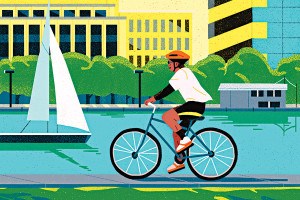Mayor Walsh Says Bike-Inclusive ‘Complete Streets’ Will Be Boston’s Default Design

Photo provided
Speaking at a Greater Boston Chamber of Commerce breakfast Thursday morning, Mayor Marty Walsh announced that “Complete Streets” would be the new standard for city planning in Boston going forward.
In a speech outlining his desire to see Boston “thinking bigger ideas” and “making bolder plans,” Walsh said he would sign an executive order making Complete Streets—an approach stressing the peaceful coexistence between cars, public transit, pedestrians, and cyclists on city streets—the new default design process for Boston.
Launched by the late Tom Menino in 2009 and spearheaded by the Boston Transportation Department, Complete Streets seeks to chip away at the car’s dominance over Boston’s roads. Designs informed by this approach can include bus shelters with amenities and real-time next bus information; electric vehicle charging stations; narrower roadways and wider sidewalks; bike and car stations like Hubway and Zipcar; and a citywide network of bike lanes and cycle tracks.
“There is no singular design prescription for Complete Streets; each one is unique and responds to each community context,” the city says on its website.
Walsh said City Hall is studying how to adjust parking meter rates in Boston’s most congested areas based on demand. “The bottom line is $1.25 an hour isn’t working in our busiest areas. I like offering a good deal, but not at the price of stress and gridlock on our streets,” he said.
Walsh also addressed July’s collapse of Boston’s bid to host the 2024 Summer Olympics, which came as public backlash over using taxpayer money to finance the megaevent reached its acrimonious apex.
“Make no mistake: we put Boston’s stamp on that global institution—by holding fast to our values. Just as important, we got a chance to look at our beautiful city through the world’s eyes, in all its greatness and in all its untapped potential,” Walsh said. “We’re going to take advantage of the planning momentum the bid created. More fundamentally, I learned from the process that we can think bigger and we can think more boldly about Boston’s future.”

